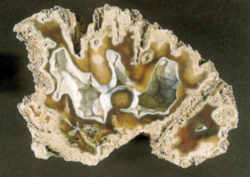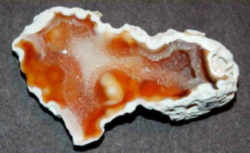
Florida Symbols
Florida State Stone (Fossil)
Agatized Coral

(Cnidaria anthozoa)
Adopted in 1979.
Florida does not yet recognize a state fossil, but its state stone, agatized coral, is actually a fossil. Agatized Corall, (Cnidaria anthozoa,) can be any of many species of corals which have been replaced by agate, a variety of quartz chalcedony. It takes a very long time to form, and most of the agatized coral found today in the state lived in the vast Eocene seas which covered the state 35-40 million years ago, when Florida was part of the continental shelf.
Florida State Stone (Fossil): Coral

Coral is the outside skeleton of tiny ocean animals called polyps, which live in colonies attached to hard underwater surfaces. When alive, polyps combine their own carbon dioxide with the lime in warm seawater to form a limestone-like hard surface, or coral.
Coral is created by sea life. It is the skeletal remains of coral polyps. Coral is calcium carbonate with a trade of carotene. Its color ranges
from white to red. Red, pink, and white coral is mostly calcium carbonate. Black and golden coral is conchiolin. It is beautiful in rings, necklaces,
and pendants.
Agatized coral occurs when silica in the ocean water hardens, replacing the limy corals with a form of quartz mineral known as chalcedony. This long
fossilization process (20-30 million years) results in the formation of a "pseudomorph," meaning that one mineral has replaced another without
having lost its original form. In 1979 agatized coral was designated the official state stone.
Agatized coral is found in three main Florida locations: Tampa Bay, the Econfina River, and the Withlacoochee/Suwannee River beds.
Scientists speculate that a massive runoff of silt rich in clay and silica may have buried the prehistoric Coral Reef alive. Much like modern day
runoff is killing many of our Reefs.
The most significant fact about the Agatized Coral found in Florida is the role it played in the lives of the first inhabitants there. Florida's warm
climate and food rich environment was always attractive to humans wanting to escape Winter weather. The first visitors found little to work with in
the way of stones. In need of spear points, knives and containers, they worked with the only materials available, a little Flint and lots of Agatized
Coral. Archeologists have dug tools dating back to 5000 BC in sites around St. Petersburg, and Wesley Chapel.
Florida Law
The law designating the agatized coral as the official Florida state fossil is found in the 2000 Florida Statutes Title IV (EXECUTIVE BRANCH) Chapter 15 (SECRETARY OF STATE) Section 15.0336
Title IV EXECUTIVE BRANCH
Chapter 15 SECRETARY OF STATE
15.0336 State stone.--Agatized coral, a chalcedony pseudomorph after coral, appearing as limestone geodes lined with botryoidal agate or quartz crystals
and drusy quartz fingers, indigenous to Florida, is hereby designated the Florida state stone.
History.--s. 1, ch. 79-278.
Taxonomic Hierarchy: Coral
Kingdom:: Animalia
Phylum: Cnidaria
Class: Anthozoa

Some states that lack a "state fossil" have nevertheless singled out a fossil for formal designation such as a state dinosaur, rock, gem or stone.






